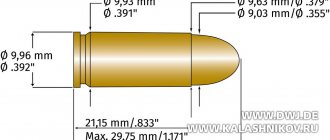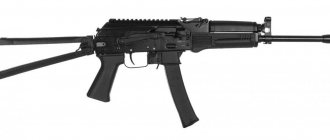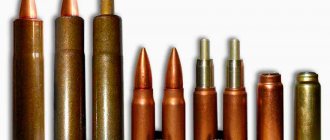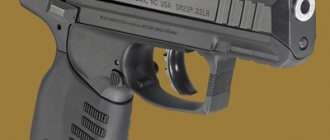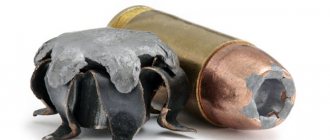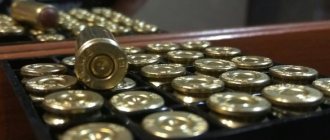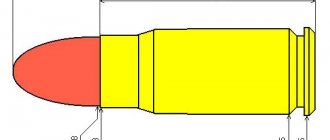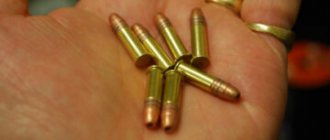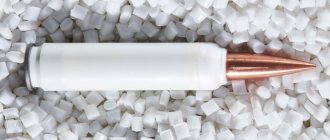Description of the KSO-9 Krechet carbine
The self-loading blowback carbine, receiver, pistol grip and trigger are taken from the KEDR submachine gun. The type of ammunition used remains the same - the Lugger 9x19 pistol cartridge.
- In order for it to fall into the category of civilian weapons, a pipe (threaded connection) was attached to the rear of the receiver, on which the sliding butt is attached. The barrel length has been increased (360 mm), and to meet the standard, an openwork brake-compensator is installed on the muzzle.
- The magazine capacity has been reduced from 30 to 10 rounds, but if desired, you can also install a combat version. The trigger has been changed, leaving one firing mode - single.
- The forend is attached to the barrel with clamps and is actually just a lining on the barrel that does not carry a structural load. It is square, with three Weaver straps attached to it for hanging the handle, tactical flashlights and other elements.
- The receiver cover received reinforcement in the form of a Weaver strip on a high bracket. There are external sighting devices - folding rear sight and front sight.
As a result of the modernization, instead of the KEDR PP, the designers ended up with something that outwardly resembles the American M4 assault rifle.
An overview of the KSO-9 Krechet carbine is given in this video:
Advantages and disadvantages
The carbine looks like it was pulled out of the movie Starship Troopers or virtual reality like RPG Mass Effect. This may warm the soul for some, but apart from the “cool” look and other show-off features, the advantages of the KSO-9 “Krechet” end there.
- The main and fatal drawback is the attempt to make a carbine chambered for a pistol cartridge. A nine-millimeter bullet with a rounded tip cannot have the same ballistic characteristics as a rifle. This is contrary to the laws of physics, so the Krechet will be inferior in all shooting indicators - accuracy, accuracy and stopping power to any carbine with a rifle bullet. For example, “Saige MK” in version 03, even despite its shorter (336 mm) barrel.
- For example: the ORSIS-120 carbine, when firing at a distance of 100 meters, gives a deviation from the aiming point of no more than 2.9 cm, which is equal to 1 MOA and therefore it falls into the standard of sniper rifles. The KEDR has dispersion at the same distance of 15 cm, which is acceptable for a submachine gun, but unacceptable for a hunting carbine.
- The carbine is all rough, angular, and has a lot of protruding parts. For hunting this is simply unacceptable. The handguard with three Weaver bars is a separate “song”. Only for fans of the “Zombie Apocalypse” this may seem like a very necessary device. For a hunter, comfort of grip and strength are more important, and a massive pad hanging on the barrel has no practical value. By the way, the American M4 assault rifle, which the Krechet is so similar to, has better ergonomics.
- The shutter handle is on the left. This is an excellent idea for a submachine gun, because if your right hand clasps the handle and your finger rests on the trigger, then after cocking you can immediately open fire. The KSO-9 Krechet carbine, which is positioned by the manufacturer as a hunting weapon, does not need this feature; it is rather dangerous.
- Separately, I would like to note the tight movement of all parts, traditional for Russian weapons. The fuse box moves with great force, which is aggravated by its small size and angularity. By the way, the bolt handle is also small and angular, making it extremely inconvenient to operate.
- Incomplete disassembly of the carbine requires tools, which also does not add convenience to its use.
Options and modifications
- The PP-71
submachine gun is a prototype developed by order of the USSR Ministry of Defense as part of the Bouquet R&D program and tested in 1969-1972. Not mass produced. - submachine gun PP-91-01 “Kedr-B”
chambered for 9×18 mm PM cartridge (with integrated silencer) - assault pistol PP-91-02 "Kedr"
- a self-loading version of the PP-91 chambered for the 9x18 mm PM cartridge, without a stock. Did not enter service, was not mass-produced - submachine gun PP-9 "Wedge"
chambered for 9x18 mm PMM, a pre-production sample was presented on April 25, 1994 at an arms exhibition in Moscow, produced in 1996-2002. for the Ministry of Internal Affairs of the Russian Federation. It features improved ballistics (due to a more powerful cartridge), increased bolt weight and the presence of helical grooves in the chamber. - submachine gun PP-919 "KEDR-2"
- developed in 1994-1996. chambered for 9×19 mm Parabellum for the Federal Tax Police Service (3 pieces produced).
- submachine gun PP-27 "Klin-2"
- an experimental version developed by A. E. Dragunov and V. M. Kalashnikov, in which the magazine neck was moved to the pistol grip fire control (layout according to the UZI scheme). A total of two prototypes were produced (one chambered for the 9×18 mm PMM cartridge and the second for the 7.62×25 mm TT cartridge) - “pistol-carbine” PKSK-10
is a self-loading version chambered for the 9x17 mm Kurz cartridge, developed for private security structures, with a 10-round magazine. The first demonstration model was presented at a weapons exhibition in February 1998; on February 18, 1998, the PKSK was certified as a service weapon. Produced in small batches since April 1998.
The PKSK service pistol differs from the KEDR submachine gun primarily in its 9×17 mm Kurz caliber. Visually, it is distinguished by a light (white) receiver cover so that law enforcement officers can visually distinguish service weapons from combat weapons. There is also a pin installed on the barrel to prevent the installation of silent and flameless shooting devices on the barrel. In addition, the PKSK does not have an automatic fire mode, and the magazine is shortened to 10 rounds.
- carbine KMO-9 "Korsak"
- a prototype, a self-loading version with an extended barrel chambered for 9x21 mm, designed as a civilian sporting, training and hunting weapon. - The KSO-9 “Krechet”
carbine is a self-loading version chambered for 9×19 mm with an extended barrel and a 10-round magazine, designed as a civilian sports training and hunting weapon. The demonstration model was first presented to the public at the “Weapons and Hunting” exhibition (Moscow, October 10-13, 2013), serial production is planned for 2014. - traumatic pistol PST "Kapral"
- a self-loading version for private security structures chambered for the 10x23 mm T cartridge, with a 10-round magazine. - traumatic pistol PDT-9T "Esaul"
- a self-loading version chambered for 9 mm R.A. cartridge, with a 10-round magazine (produced since 2005). - traumatic pistol "Esaul-2"
- a fully automatic version chambered for 9 mm R.A., a demonstration sample was made, but the weapon was not certified and was not mass-produced - traumatic pistol PDT-13T "Esaul-3"
- self-loading version chambered for .45 Rubber, with a 10-round magazine (developed in 2009) - “Kedr-MD”
is a submachine gun for firing only blank cartridges, developed by order of the Mosfilm film concern in 2006; a total of 5 pieces were produced. - PP-9 "Wedge"
- version chambered for 9x19 mm Parabellum cartridge.
the 4.5-mm PPA-K Tirex air pistol was presented to the public and has been mass-produced since 2007
, which has an external resemblance to PP-91.
Automatic and submachine gun
Let's start from afar. What, exactly, is the difference between a machine gun and a pistol? Automatic, by the way, is an exclusively domestic term. The world has adopted another name for this type of weapon: assault rifle. The weapon is designed for the so-called intermediate cartridge - 5.45x39 or 5.56x45. It is moderately powerful, optimal for burst fire. The type of automatic reloading is not particularly important, but the gas principle is more often used. The long barrel allows for targeted shooting over a considerable distance.
A submachine gun is also an automatic weapon that supports continuous fire, but is much more compact, with a shorter barrel. Intended for use at short distances, in confined spaces, for security and defensive actions, not offensive. For this reason, submachine guns use pistol cartridges with low power and bullet speed and the corresponding type of mechanics - usually the so-called blowback action.
Russian legislation does not allow citizens to own short-barreled firearms - pistols, revolvers, and also, of course, submachine guns due to their small dimensions, which do not fit into the requirement for the minimum permissible length of weapons. We only use “long-barreled guns” - shotguns, rifles and carbines - mainly with hunting functionality.
Popular sports and recreational shooting from such weapons has its own nuances and limitations: strong noise and recoil, high cost of ammunition, the danger that a rifled cartridge bullet retains at a great distance, and restrictions in the rules of many shooting ranges. Therefore, for those who like to shoot a lot, often and inexpensively, but are not satisfied with a small caliber (.22), a separate class of weapons has appeared - self-loading carbines chambered for a pistol cartridge and with submachine gun mechanics. They are perfect for sports and amateur dynamic shooting. With such a weapon you can visit any shooting range certified for a pistol and with short galleries. The shot is not as powerful as that of a 12-gauge, and the bullet loses its lethal energy much earlier, unlike, say, 7.63x39.
Here are a few typical and popular models of weapons that represent this still specific and not very broad segment.
Design
PP-91 has an extremely simple and technologically advanced design.
The automatic operation of a submachine gun is based on the use of the recoil energy of a blowback bolt. A hammer-type trigger mechanism allows firing in single and automatic modes. The cartridges are fed from a double-row box magazine. To increase stability when firing, the submachine gun is equipped with a shoulder rest that folds over the receiver.
The receiver is rectangular, stamped from sheet steel, and has a removable cover. The 120 mm long barrel is rigidly mounted in the receiver, to which the pistol grip, magazine receiver and folding stock are attached. Sights are open type. The front sight is mounted on the barrel at the front wall of the receiver, the rear sight is mounted on top of the folding butt attachment. When the butt is folded down, the diopter rear sight is rotated to the working position; when the butt is folded into the stowed position, the open rear sight is rotated. The weapon can be equipped with a BK-09 silencer and a Pion-M laser target designator.
Before firing, the bolt of the submachine gun, under the action of the return spring, occupies the extreme forward position. When fired, powder gases acting on the bottom of the cartridge case move the massive bolt to the rearmost position. At the same time, the bolt removes the spent cartridge case from the chamber and throws it out of the receiver, cocks the hammer and compresses the return spring. The bolt rolls into the forward position under the action of the return mechanism. At the same time, he sends another cartridge into the chamber and locks the barrel. Locking is carried out due to the inertia of the bolt and the forces of the return spring. When the safety switch is set to automatic firing, it will continue as long as the trigger is pressed and there are cartridges in the magazine. When installing the safety switch for single firing, after each shot you must release the trigger and press it again to fire the shot.
KSO-9 "Krechet"
Zlatoust Machine-Building Plant produces its own version of a submachine gun with the appearance of an assault rifle - KSO-9 “Krechet”. The semi-automatic carbine is based on the well-known PP-91 “Kedr” submachine gun by Evgeny Dragunov. In the guise of the Krechet, a trained eye will easily spot the familiar Kedr box with its characteristic strictly vertical magazine shaft. However, what distinguishes the Krechet from the compact submachine gun is its long barrel (360 mm), protected by a false fore-end with three integrated Weaver straps for hanging the handle, tactical flashlights and other tuning elements, as well as a tactical polymer stock with adjustable length and an intimidating, but quite useless muzzle brake-compensator.
According to the tradition accepted in Russia, the Krechet carbine is factory-made, although in reality it, like the Saiga-9, is intended only for sports and “hobby” target shooting at distances of about 50 meters.
In this capacity, “Krechet” is not bad for lovers of “tactical-cosmic” looking weapons. However, if hunting from an oversized submachine gun is so important to its owner, from the Krechet he can quite successfully shoot, say, a beaver...
"Saiga-9"
The most famous and best-selling line of civilian weapons from Izhmash is, of course, the Saiga family of Kalashnikov-like carbines. “Kalashmats,” as they are affectionately called by the people, are presented on the civilian weapons market in a wide variety of smooth-bore and rifled versions - for hunting, sports and recreational shooting.
However, this time appearances were deceiving. Under the familiar outlines of a Kalash with a 367 mm long barrel lies the filling of the PP-19-01 Vityaz submachine gun. It was developed in Izhevsk in 2004 as a simplified version of the PP-19 “Bison” - the brainchild of the sons of famous designers Mikhail Kalashnikov and Evgeny Dragunov. The fact is that it is impossible to take and make a version of the Kalashnikov with a 9-mm caliber barrel and the corresponding magazine: the low-power 9x19 pistol cartridge is not suitable for a gas-operated machine gun, designed for ammunition with a completely different energy. As a result, the Saiga-9 only had the appearance of the Kalashnikov, but the mechanics were completely changed. The gas-operated reloading system was replaced by a blowback system from the Vityaz, adopted as the standard in the submachine gun segment. The characteristic casing of the gas tube, by which both an AK and any Saiga are immediately recognizable, was left as a prop in order to preserve the look familiar to many.
PPSh 9x19
The famous Soviet PPSh from the Great Patriotic War - the Shpagin submachine gun - also did not remain aloof from the “transition to peaceful life” in the 21st century. It was produced a lot as a civilian weapon - under the names PPSh-O, PPSh-Luger 9x19, VPO-135. In Kovrov, they first took old wartime PPSh from warehouses, deactivated the automatic firing function in them, put cream marks in the barrels and offered them for sale under the original “bottle” TT cartridge. Some of them were bought in bulk by a factory in Vyatskie Polyany, where the barrels were replaced with 9-mm ones and the weapons were remarked with their own brands, overwriting the Kovrov stamps. After the appearance of a legislative ban on the “fencing” of decommissioned military weapons, the production of 9-mm PPSh has already continued in the form of production “from scratch”, without using retro copies of warehouse storage as a basis.
One way or another, buying the famous “PaPaShu” today is not a problem - both in a store and second-hand, from your own hands. Even in completely new versions, it retained its essence and spirit, having actually changed only the caliber.
Unlike Saiga and Krechet, PPSh are purchased, as a rule, not for the purpose of practical sport shooting, but out of love for art by collectors and connoisseurs of military history. Plus, many fans of practical shooting want to own the weapon with which their grandfathers and great-grandfathers fought, and to experience with their own hands all the features of its operation, advantages and disadvantages.
Description of the KSO-9 Krechet carbine
The self-loading blowback carbine, receiver, pistol grip and trigger are taken from the KEDR submachine gun. The type of ammunition used remains the same - the Lugger 9x19 pistol cartridge.
- In order for it to fall into the category of civilian weapons, a pipe (threaded connection) was attached to the rear of the receiver, on which the sliding butt is attached. The barrel length has been increased (360 mm), and to meet the standard, an openwork brake-compensator is installed on the muzzle.
- The magazine capacity has been reduced from 30 to 10 rounds, but if desired, you can also install a combat version. The trigger has been changed, leaving one firing mode - single.
As a result of the modernization, instead of the KEDR PP, the designers ended up with something that outwardly resembles the American M4 assault rifle.
Advantages and disadvantages
The carbine looks like it was pulled out of the movie Starship Troopers or virtual reality like RPG Mass Effect. This may warm the soul for some, but apart from the “cool” look and other show-off features, the advantages of the KSO-9 “Krechet” end there.
- The main and fatal drawback is the attempt to make a carbine chambered for a pistol cartridge. A nine-millimeter bullet with a rounded tip cannot have the same ballistic characteristics as a rifle. This is contrary to the laws of physics, so the Krechet will be inferior in all shooting indicators - accuracy, accuracy and stopping power to any carbine with a rifle bullet. For example, “Saige MK” in version 03, even despite its shorter (336 mm) barrel.
- For example: the ORSIS-120 carbine, when firing at a distance of 100 meters, gives a deviation from the aiming point of no more than 2.9 cm, which is equal to 1 MOA and therefore it falls into the standard of sniper rifles. The KEDR has dispersion at the same distance of 15 cm, which is acceptable for a submachine gun, but unacceptable for a hunting carbine.
- The carbine is all rough, angular, and has a lot of protruding parts. For hunting this is simply unacceptable. The handguard with three Weaver bars is a separate “song”. Only for fans of the “Zombie Apocalypse” this may seem like a very necessary device. For a hunter, comfort of grip and strength are more important, and a massive pad hanging on the barrel has no practical value. By the way, the American M4 assault rifle, which the Krechet is so similar to, has better ergonomics.
- The shutter handle is on the left. This is an excellent idea for a submachine gun, because if your right hand clasps the handle and your finger rests on the trigger, then after cocking you can immediately open fire. The KSO-9 Krechet carbine, which is positioned by the manufacturer as a hunting weapon, does not need this feature; it is rather dangerous.
- Separately, I would like to note the tight movement of all parts, traditional for Russian weapons. The fuse box moves with great force, which is aggravated by its small size and angularity. By the way, the bolt handle is also small and angular, making it extremely inconvenient to operate.
- Incomplete disassembly of the carbine requires tools, which also does not add convenience to its use.
With all the listed shortcomings, its price exceeds 50 thousand rubles. Now compare “CEDAR” and “Jager” (by the way, they have the same weight - 3.2 kg), which cost the same, and you will understand how justified the purchase of a product from Chrysostom is.
Carbine KSO-9 Krechet (photo)
Self-loading hunting carbine model KSO-9 “Krechet” caliber 9x19
Information from the registry:
Chapter:
Certificates of conformity for products included in the Unified List of Products of the Russian Federation
Registration number of the certificate of conformity:
ROSS RU.MZh03.V03016
Certificate validity start date:
30.03.2015
Certificate expiration date:
29.03.2018
Submitted documents:
TU 718131-100-07554931-2013
Reason for issuing the certificate:
test report No. 4200 dated 03/27/2015 of the State Test Center for testing civilian and service weapons and ammunition for them FBU “Udmurt TsSM”, accreditation certificate No. ROSS RU.0001.21МЖ26; test report for compliance with the forensic requirements of the Ministry of Internal Affairs of the Russian Federation No. 2820 dated 27.03 .2015 State Testing Center for testing civilian and service weapons and ammunition FBU “Udmurt TsSM”, accreditation certificate No. ROSS RU.0001.21МЖ26
Applicant type:
entity
Applicant type:
Manufacturer
Organizational and legal form of the applicant:
Joint-Stock Company
Full name of the applicant:
Joint Stock Company “Zlatoust Machine-Building Plant” (JSC “Zlatmash”)
Applicant's location address:
456208, Russia, Chelyabinsk region, Zlatoust, Parkovy proezd, 1
Applicant's actual address:
456208, Russia, Chelyabinsk region, Zlatoust, Parkovy proezd, 1
Manufacturer type:
entity
Organizational and legal form of the manufacturer:
Joint-Stock Company
Manufacturer's full name:
Joint Stock Company “Zlatoust Machine-Building Plant” (JSC “Zlatmash”)
Manufacturer's location address:
456208, Russia, Chelyabinsk region, Zlatoust, Parkovy proezd, 1
Manufacturer's INN:
7404052938
Type of certification object:
Serial release
Product type:
Domestic
Information about the product (type, brand, model, grade, article number, etc.) ensuring its identification:
Self-loading hunting carbine model KSO-9 “Krechet” caliber 9x19
Code according to the All-Russian Product Classifier (OKP):
Code according to the Commodity Nomenclature of Foreign Economic Activity (TN FEA):
9303300000
Unified list of products - for GOST R certificates:
carabiners over 7 mm
Designation of a national standard or code of practice:
GOST R 50529-2010 (p. 4),”Forensic requirements for the technical characteristics of civilian and service weapons, as well as cartridges for them”
Full name of the Certification Body that registered the certificate:
Certification body for civilian and service weapons and ammunition of the Limited Liability Company “Udmurt Certification Center”
Certification body certificate number:
ROSS RU.0001.11МЖ03
Legal address of the certification body:
426069, Russian Federation, Udmurt Republic. Izhevsk, st. Nizhnyaya, 32
Address of the location of the certification body:
426069, Udmurt Republic. Izhevsk, st. Nizhnyaya, 32
Certificate registration date:
12.04.2011
Certification body telephone number:
(3412) 582632, 593943
Certification body fax number:
(3412) 593876
Certification body email address:
Last name First name Patronymic of the expert:
Golovin Alexander Vladimirovich
